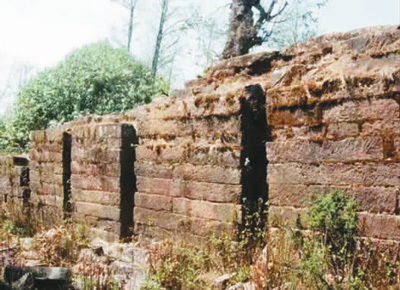
Remaining walls of houses in Fengjia Ancient City.
The ancient city of Fengjia, on the Santai Mountain in the remnants of the majestic Wumeng Mountains, was the base camp of the Luowu tribe of the Yi nationality in the southwest of the Megatron during the Tang, Song, Yuan and Ming Dynasties.
Santa Mountain, located at the junction of Wuding County and Luquan Yi and Miao Autonomous County in Yunnan Province, is 2,600 meters above sea level. ” so named. In the Yuan and Ming Dynasties, it was a famous mountain in the southwest.
On the left cliff of the mountain road leading to the ancient city of Fengjia, there are two stone statues carved. On the left is the statue of the great sage Northern Duowen Tianwang, which is 3.6 meters high and 1.4 meters wide. The eyes are slanted upward, the eyebrows are sullen, the nose and mouth are wide, the head is wearing a crown, the ear is wearing a pendant, the armor is wearing, the folds are flowing, and the lines are dense and dense. . On the right is the statue of the “Great Saint Mahakala, the Great God of Darkness”. It is 4.52 meters high, with a burly body, a broad face, thick eyebrows and angry eyes; four arms stretched out, a halberd in the right front, and a Buddhist bead in the right rear; the left front is bent Elbow in front of chest, left rear hand to tower. The two stone statues were introduced through the ancient Silk Road in the south, and have high artistic value and ornamental value.
Climb to the top of the mountain, and the long-awaited Fengjia Ancient City will appear in front of you. The city wall is 1.5 meters thick, the highest residual section is 2 meters, the circumference is 360 meters, the inner diameter is 118 meters from north to south, and 102 meters from east to west. It can be seen from the residues that the southern end of the castle is the original gate, the entrance is a rectangular outer courtyard, and the two sides are the ruins of stables and other houses. From the outer courtyard, go up the stone steps and enter a gate, which is a quadruple inner courtyard; the quadruple courtyard is raised in the shape of a platform until it reaches the front of the main hall. There is a screen wall between each two courtyards, and there is a step and a door in the middle for access; the east and west sides of each courtyard are used for entry and exit. , each with two or three-bay wing rooms; two flagpole stone piers in front of the wing rooms on both sides of the second courtyard; behind each wing room there is a side room, and the front room and the side room each form a small side courtyard. The back wall and the left and right gables of the main hall are made of fine-worked fine strip stones, built with lime mortar, and the wall thickness is 1 meter; the highest residual gable is 19 layers of lime mortar bricks, and the height is 4 meters; Residential building. There are drying fields, granaries, barracks, prisons, water diversion facilities and other facilities around the castle, which together with the main building constitute a complete production and living system. The entire Fengjiacheng has a strict structure and proper layout, representing the highest architectural level of the Luowu tribe of the Yi nationality at that time.
The Luo Wu tribe of the Yi nationality was a tribe that once dominated the southwest of the motherland. During the Song Chunxi years (1174-1189 AD), the king of Dali, Duan Zhixing, named A Er as the minister of Luo Wu, unified the various ministries and established the feudal lord regime. During the Dali Kingdom period of the Song Dynasty, the Feng family of the Luo Wu tribe of the Yi nationality chose the site of Santai Mountain to build the ancient city and became the base camp. The ancient city of Fengjia was destroyed during the Ming Dynasty.
The ancient city has gone, but the green hills remain. Santai Mountain, where the ancient city is located, has a primitive ecology and beautiful nature. The mountain is covered with Yunnan pine, Yunnan camellia, fir tree, hemp oak, rhododendron and other plants. At the turn of spring and summer, wild flowers such as wax plum, Yunnan camellia, mountain magnolia, and mountain rhododendron bloom all over the mountains and fields. In summer and autumn, wild mushrooms and wild vegetables such as mountain onion, bracken, mountain strawberry, fragrant mushroom, matsutake mushroom, chicken fir, bolete, hydrangea, fungus and morel can be picked everywhere. Wild animals such as pangolins, civet cats, red-bellied squirrels, civet cats, badgers, porcupines, Yunnan box turtles, wild boars, badgers, and owls can often be seen in the bushes and forests. Looking around, the mountains are covered with dais, the mist is shrouded in mist, and the scenery is beautiful, as if you are in a giant oil painting. Every weekend or holiday, it attracts many tourists to visit and visit.